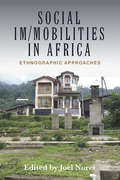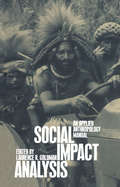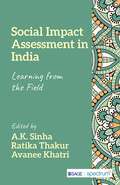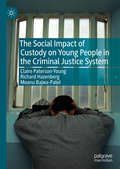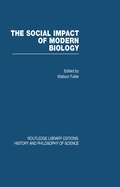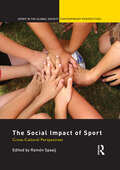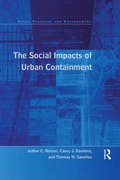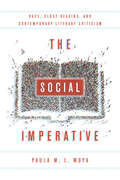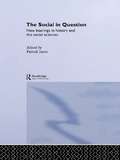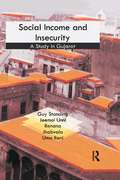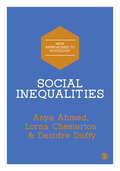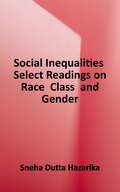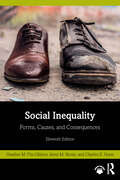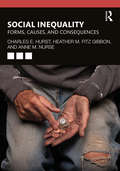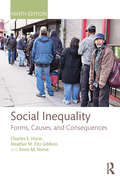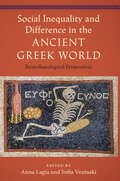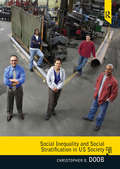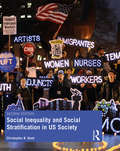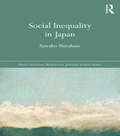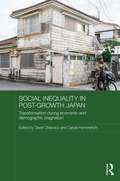- Table View
- List View
Social Im/mobilities in Africa: Ethnographic Approaches
by Joël NoretGrounded in both theory and ethnography, this volume insists on taking social positionality seriously when accounting for Africa’s current age of polarizing wealth. To this end, the book advocates a multidimensional view of African societies, in which social positions consist of a variety of intersecting social powers - or ‘capitals’ – including wealth, education, social relationships, religion, ethnicity, and others. Accordingly, the notion of social im/mobilities emphasizes the complexities of current changes, taking us beyond the prism of a one-dimensional social ladder, for social moves cannot always be apprehended through the binaries of ‘gains’ and ‘losses’.
Social Imaginary and the Metaphysical Discourse: On the Fundamental Predicament of Contemporary Philosophy and Social Sciences (Routledge Studies in Social and Political Thought)
by Christoforos BouzanisThis book departs from approaches to truth in social science and ideas in philosophy that connect truth to the ability of language to fulfil certain ‘real-world’ conditions of objectivity. Pointing to an extra-linguistic level in our cognition at which scientific creativity occurs, it highlights the manner in which epistemic communities share, work on and modify not only the world-imaginaries that they endorse, but also those world-views that they reject or which partially overlap with their own. Through the concept of the social imaginary, the author explores the theoretical interrelations among various metaphysical world-imageries by which we organise our scientific understanding of the world and our expectations of experience, thus shedding light on the manner in which social ontology can inform our practices of sharing belief. A study at the intersection of metaphysics and social theory, The Fundamental Predicament of Contemporary Philosophy and the Social Sciences will appeal to scholars of sociology and philosophy with interests in questions of ontology and epistemology.
Social Impact Analysis: An Applied Anthropology Manual
by Laurence R. GoldmanThis book addresses the nature, purpose and processes associated with social impact analysis. Because resource development projects occur in human as well as ecological environments, stakeholders - landowners, companies and governments - are compelled to ensure that the benefits of any project are maximized while the negative risks are minimized. Achieving such objectives means implementing programs which monitor and evaluate the ongoing effects of a project on the social and cultural lives of the impacted populace. This book aims to provide a teaching and training resource for students, social scientists (anthropologists, sociologists, human geographers, environmentalists, engineers, etc.) and indigenous personnel and operators who are tasked with community affairs programs in those countries where resource development projects are implemented. The constituent chapters provide how-to guides and frameworks that are generously illustrated with case studies drawn variously from North America and the Asia-Pacific region. Topics addressed include Legal Frameworks and Compliance Procedures, Social Mapping, Environmental Reports, Social and Economic Impact Studies, Social Monitoring Techniques, Project Development, Statistical Packages and Report Production.This book is unique in so far as it seeks to prioritize application over theory. Moreover, it is the first training resource that is sensitive to non-western indigenes' need to assimilate and apply skills engendered by Western countries.
Social Impact Assessment in India: Learning from the Field
by A. K. Sinha Ratika Thakur Avanee KhatriThis book is a discourse on social impact assessment (SIA), an important tool for identifying and managing impacts of a development project. It provides an outlook on judicial, methodological and ethical complexities in SIA. The book also offers anthropological critique of SIA and collates experiences of practitioners and researchers from India, with the objective of sharpening SIA with redefined practices. Social Impact Assessment in India discusses direct and indirect impacts on project-affected people (displaced and relocated) and the role (ethical and financial) of funding agencies, including legalities and associated vulnerabilities. The strength of this book lies in its field-based approach revealing ground realities and the authors' reflections and insights on situations on the field, across different regions of India.
The Social Impact of Custody on Young People in the Criminal Justice System
by Claire Paterson-Young Richard Hazenberg Meanu Bajwa-PatelThis book explores the journey of young people through a Secure Training Centre and, more generally, the criminal justice system in the UK. It examines the extent to which young people have been failed by the system at every stage of their lives, with incarceration used as a means of removing ‘the problem’ from society. To explore this process, the authors utilise an integrated theoretical framework to develop a new rehabilitative approach focused on developing positive outcomes for young people. The book deploys a social impact measurement methodology to evaluate the experience and outcomes of youth justice interventions at a Secure Training Centre. Such an approach provides a fresh perspective on the youth justice debate which has traditionally utilised outcome data to measure immediate impact relating to recidivism and is therefore not focused on the young person holistically. Using a social impact framework to evaluate youth justice, underpinned by an integrated theoretical framework, allows for assessment to be made which place the young person at the centre of evaluation.
The Social Impact of Modern Biology (Routledge Library Editions: History & Philosophy of Science)
by Fuller WatsonOriginally published in 1971. Discoveries in modern biology can radically change human life as we know it. As our understanding of living processes, such as inheritance, grows, so do the possibilities of applying these results for good and evil, such as the treatment of disease, the control of ageing, behaviour and genetic engineering. These discoveries and their implications are discussed by some of the world’s leading biologists.
The Social Impact of Sport: Cross-Cultural Perspectives (Sport in the Global Society – Contemporary Perspectives)
by Ramón SpaaijThis book critically examines the ways in which sports contribute to, or inhibit, social well-being, the directions these changes take and the conditions necessary for sport to have beneficial outcomes. The themes addressed in the book demonstrate the diversity and versatility of the social impacts sport can potentially achieve as well as the variable benefits of sport in different social contexts. The contributions are focused around four major themes:- Sport development and social change: intended and unanticipated consequences- Empowerment and personal change through sport- Sport participation, social inclusion and social change- The impact of sport in society: historical and comparative perspectivesThe volume constitutes the first scholarly attempt to locate, compare and conceptualize the social impact of sport in different local, national and international contexts. Through international comparison and empirically grounded case studies the book provides an important new departure in the study of the social meanings of sport in society, linking themes and areas that have previously been studied merely separately from one another.This book was previously published as a special issue of Sport in Society.
The Social Impacts of Climate Change in China over the Past 2000 Years
by Xiuqi Fang Yun Su Jingyun Zheng Lingbo Xiao Zhudeng Wei Jun YinThis book aims to illustrate how climate change had impacted the socio-economic development in the history of China, under the framework of food security. The 10 years resolution sequences indexing the status of social and economic subsystems in China over the past 2000 years are reconstructed. Statistical methods are used to reveal the major characters and main process of the impact of historical climate change on China's social economy. This book serves as a reference both for researchers, graduates, and undergraduates majoring in geography, climatology, history, and other related fields.
The Social Impacts of Urban Containment (Urban Planning And Environment Ser.)
by Arthur C. Nelson Casey J. DawkinsOne of the policies that has been most widely used to try to limit urban sprawl has been that of urban containment. These policies are planning controls limiting the growth of cities in an attempt to preserve open rural uses, such as habitat, agriculture and forestry, in urban regions. While there has been a substantial amount of research into these urban containment policies, most have focused on issues of land use, consumption, transportation impacts or economic development issues. This book examines the effects of urban containment policies on key social issues, such as housing, wealth building and creation, racial segregation and gentrification. It argues that, while the policies make important contributions to environmental sustainability, they also affect affordability for all the economic groups of citizens aside from the most wealthy. However, it also puts forward suggestions for revising such policies to counter these possible negative social impacts. As such, it will be valuable reading for scholars of environmental planning, social policy and regional development, as well as for policy makers.
The Social Imperative
by Paula MoyaIn the context of the ongoing crisis in literary criticism, The Social Imperative reminds us that while literature will never by itself change the world, it remains a powerful tool and important actor in the ongoing struggle to imagine better ways to be human and free. Figuring the relationship between reader and text as a type of friendship, the book elaborates the social-psychological concept of schema to show that our multiple social contexts affect what we perceive and how we feel when we read. Championing and modeling a kind of close reading that attends to how literature reflects, promotes, and contests pervasive sociocultural ideas about race, ethnicity, gender, and sexuality, Paula M. L. Moya demonstrates the power of works of literature by writers such as Junot Diaz, Toni Morrison, and Helena Maria Viramontes to alter perceptions and reshape cultural imaginaries. Insofar as literary fiction is a unique form of engagement with weighty social problems, it matters not only which specific works of literature we read and teach, but also how we read them, and with whom. This is what constitutes the social imperative of literature.
The Social in Question: New Bearings
by Patrick JoyceWith postmodernism has come the questioning of the very idea of 'the social'. Thinkers form across the social sciences and humanities now agree that this one foundational concept can no longer be taken for granted as an objective or real characteristic of the world. However, their uncertainty has taken on many guises and the social in Question represents an attempt to pull these diverse forms of questioning together.Drawn form sociology, cultural studies, history and theology, an international and eminent cast of contributors look at how the idea of 'the social' developed from its mediaeval foundations to its consolidation in the early twentieth century. The book then charts how the concept has been brought into the question by critiques from science studies, cultural studies and postcolonial studies before going on to look at how new framework are being proposed for the exploration of issues formerly seen as 'the social'. This book makes a fascinating contribution to the rethinking of contemporary academic activity.
Social Inclusion and Education in India: Scheduled Tribes, Denotified Tribes and Nomadic Tribes
by Ghanshyam Shah Joseph BaraThis book examines social inclusion in the education sector in India for scheduled tribes (ST), denotified tribes and nomadic tribes. It investigates the gaps between what was promised to the marginalized sections in the constitution, and what has since been delivered. The volume:• Examines data from across the Indian states on ST and non-ST students in higher, primary and secondary education;• Analyses the success and failures of education policy at the central and state level;• Brings to the fore colonial roots of social exclusion in education. A major study, the volume will be of great interest to scholars and researchers of education, sociology and social anthropology, development studies and South Asian studies.
Social Income and Insecurity: A Study in Gujarat
by Guy Standing Renana Jhabvala Jeemol Unni Uma RaniEconomic liberalisation associated with globalisation is causing a pervasive growth of economic insecurity experienced all over the world. This is placing urgent demands on policymakers to rethink old policies and institutions. This book sets out a new approach to the assessment of income dynamics, based on identifying the diverse components of people’s income and entitlements. It defines ‘social income’ as a broader concept of household income which includes state, community and private benefits. It shows how those components should be measured and provides a composite picture of the structure of incomes and support systems of different societal groups. It recognises how the structure of income, as well as its distribution, has been linked to policy and development dynamics. It starts from a premise that unless the totality of incomes and income support systems is taken into account, academics and policymakers cannot expect to develop appropriate interventions. This perspective is developed though a detailed household survey conducted in rural and urban areas of Gujarat in 2007–2008. This provides an up-to-date picture of how institutions, NGOs and the state system are operating in the context of rapid restructuring of village life in India.
Social Inequalities (New Approaches to Sociology)
by Anya Ahmed Deirdre Duffy Lorna ChestertonPart of the New Approaches to Sociology series, Social Inequalities is a relevant and valuable exploration of how we see the world, through a decolonised lens. Aimed at undergraduate and postgraduate students of sociology, this textbook offers a critical re-reading of traditional approaches to understanding social inequalities and responds to the call from university administrations, academics and students to decolonise the curriculum and challenge its lack of diversity. It presents an intersectional approach to understanding diversity and social inequalities and, in so doing, allows for alternative knowledge sources and voices to be heard. From looking at social groups such as race, age, sexuality and class alongside a nuanced evaluation of traditional sociological theories such as Marxism, functionalism and feminism – this book is an expert guide to the debates central to understanding the challenges individuals face in society. Including personal stories and case studies, students will be exposed to an authentic and real-world view of how individuals have encountered discrimination. Social Inequalities is an essential resource for anyone working and studying across sociology, and anyone interested in challenging established ways of looking at the world. Professor Anya Ahmed, Dr Deirdre Duffy and Dr Lorna Chesterton work in the faculty of health and education at Manchester Metropolitan University, UK.
Social Inequalities (New Approaches to Sociology)
by Anya Ahmed Deirdre Duffy Lorna ChestertonPart of the New Approaches to Sociology series, Social Inequalities is a relevant and valuable exploration of how we see the world, through a decolonised lens. Aimed at undergraduate and postgraduate students of sociology, this textbook offers a critical re-reading of traditional approaches to understanding social inequalities and responds to the call from university administrations, academics and students to decolonise the curriculum and challenge its lack of diversity. It presents an intersectional approach to understanding diversity and social inequalities and, in so doing, allows for alternative knowledge sources and voices to be heard. From looking at social groups such as race, age, sexuality and class alongside a nuanced evaluation of traditional sociological theories such as Marxism, functionalism and feminism – this book is an expert guide to the debates central to understanding the challenges individuals face in society. Including personal stories and case studies, students will be exposed to an authentic and real-world view of how individuals have encountered discrimination. Social Inequalities is an essential resource for anyone working and studying across sociology, and anyone interested in challenging established ways of looking at the world. Professor Anya Ahmed, Dr Deirdre Duffy and Dr Lorna Chesterton work in the faculty of health and education at Manchester Metropolitan University, UK.
Social Inequalities: Select Readings on Race, Class, and Gender
by Sneha Dutta HazarikaFeaturing an intersectional approach, this text introduces students to social inequalities embedded within society at both the micro and macro level. Through compelling, scholarly articles, students gain the knowledge necessary to address social inequalities and inspire social change. The anthology features six distinct units. <p><p>Unit I focuses on race, racism, and immigration and features readings on racial formation, defining racism, and the consequences of racism on U.S. immigration policy. In Unit II, students read about gender, patriarchy, and formal and informal discrimination against women at work. Unit III features coverage of social class, power, and privilege, and Unit IV speaks to the tensions between wealth, privilege, and inequality. Students learn about inequality and discrimination within social institutions like schools, housing, and mass incarceration. The final unit encourages students to pursue social change and social transformation. <p><p>This book is an ideal reader for courses in sociology, women and gender studies, and race and ethnic studies, as well as those that address social stratification and the intersectionality of race, ethnicity, class, and gender.
Social Inequality: Forms, Causes, and Consequences
by Heather M. Fitz Gibbon Anne M. Nurse Charles E. HurstThe eleventh edition of Social Inequality: Forms, Causes, and Consequences is an introduction to the study of social inequality. Fully updated statistics and examples convey the pervasiveness and extent of social inequality in the United States. The authors use an intersectional perspective to show how inequality occurs, how it affects all of us, and what is being done about it. With more resources and supplementary examples, exercises, and applications embedded throughout to aid students’ learning and visualization of important concepts, the book provides a rich theoretical treatment to address the current state of inequality. In line with current affairs, the authors have expanded the content to include: An intersectional approach throughout the chapters; A stronger emphasis on the connections between poverty, wealth, and income inequality; New case studies on the opioid epidemic, COVID-19, the lead poisoning crisis, and climate change; A new focus on the rise of right-wing movements. With additional content and classroom extensions available online for instructors, Social Inequality remains an ideal and invaluable overview of the subject and provides undergraduate students with a robust understanding of social inequality from a sociological perspective.
Social Inequality: Forms, Causes, and Consequences
by Charles E. Hurst Heather M Fitz Gibbon Anne M NurseLike past editions, this tenth edition of Social Inequality: Forms, Causes, and Consequences is a user-friendly introduction to the study of social inequality. This book conveys the pervasiveness and extensiveness of social inequality in the United States within a comparative context, to show how inequality occurs, how it affects all of us, and what is being done about it. This edition benefits from a variety of changes that have significantly strengthened the text. The authors pay increased attention to disability, intersectionality, immigration, religion, and place. This edition also spotlights crime and the criminal justice system as well as health and the environment. The tenth edition includes a new chapter on policy alternatives and venues for social change.
Social Inequality: Forms, Causes, and Consequences
by Charles E. Hurst Heather M. Fitz Gibbon Anne M. NurseLike past editions, this ninth edition of Social Inequality: Forms, Causes, and Consequences is a user-friendly introduction to the study of social inequality. This book conveys the pervasiveness and extensiveness of social inequality in the United States within a comparative context, to show how inequality occurs, how it affects all of us, and what is being done about it. This edition benefits from a variety of changes that have significantly strengthened the text. The authors pay increased attention to disability, transgender issues, intersectionality, experiences of Muslims, Hispanic populations, and immigration. The 9th edition also includes content on the fall-out from the recession across various groups. The sections on global inequalities have been greatly updated, emphasizing comparative inequalities and the impact of the process of globalization on inequality internationally. The authors have also added material on several current social movements, including Occupy Wall Street, Black Lives Matter, and Marriage Equality.
Social Inequality and Difference in the Ancient Greek World: Bioarchaeological Perspectives (Bioarchaeological Interpretations of the Human Past: Local, Regional, and Global Perspectives)
by Anna Lagia Sofia VoutsakiExploring the relationship between health and inequality in the societies of ancient GreeceIn this volume, bioarchaeologists, osteologists, archaeologists, and paleopathologists examine the ways social inequalities and differences affected health and wellbeing in ancient Greece. Although the ancient Greek civilization is often associated with the ideals of democracy and social equality, the region was characterized by pervasive divisions. Moving beyond elitism and idealization, this book focuses on health-related disparities and difference.Case studies cover a wide temporal range—from the eleventh century BCE through the sixth century CE, a period not usually examined in bioarchaeological studies of the region—and geographical areas including city-states in the Greek mainland, the Aegean islands, the Ionian coast, Albania, and Southern Italy. Comparing health-related data across social groups and sociopolitical systems, contributors explore the relationships between colonists and Indigenous communities, strategies of inclusion and exclusion in mortuary practices, and the impact of urbanization and Romanization on health, diet, and growth. This book also discusses methodological questions such as the challenges posed by poor skeletal preservation, small sample sizes, and incomplete or legacy data.With a focus on marginalized groups including ordinary people, women, children, and enslaved workers, Social Inequality and Difference in the Ancient Greek World shows how bioarchaeology can dialogue with the disciplines of archaeology and ancient history to explore subjects such as health, inequality, ethnicity, age, and gender. This book opens a new avenue for addressing questions concerning living standards in the ancient world. Contributors: Hannah Liedl | Lukas Waltenberger | Britney Kyle | Dimitra Ermioni Michael | Victoria Sabetai | Carrie L. Sulosky Weaver | Anna Lagia | Elena Vlachogianni | Sandra Garvie-Lok | Jane Buikstra | Reine-Marie Bérard | Christina Papageorgopoulou | Efthymia Nikita | Aliya R. Hoff | Eleni-Anna Prevedorou | Sofia Voutsaki | Lisa Steige | Sam Cleymans | Paraskevi TritsaroliA volume in the series Bioarchaeological Interpretations of the Human Past: Local, Regional, and Global Perspectives, edited by Clark Spencer Larsen
Social Inequality and Social Stratification in U.S. Society
by Christopher B. DoobSocial Inequality - examining our present while understanding our past. Social Inequality and Social Statification in US Society, 1st edition uses a historical and conceptual framework to explain social stratification and social inequality. The historical scope gives context to each issue discussed and allows the reader to understand how each topic has evolved over the course of American history. The authors use qualitative data to help explain socioeconomic issues and connect related topics. Each chapter examines major concepts, so readers can see how an individual's success in stratified settings often relies heavily on their access to valued resources-types of capital which involve finances, schooling, social networking, and cultural competence. Analyzing the impact of capital types throughout the text helps map out the prospects for individuals, families, and also classes to maintain or alter their position in social-stratification systems. Learning Goals Upon completing this book, readers will be able to: Analyze the four major American classes, as well as how race and gender are linked to inequalities in the United States Understand attempts to reduce social inequality Identify major historical events that have influenced current trends Understand how qualitative sources help reveal the inner workings that accompany people's struggles with the socioeconomic order Recognize the impact of social-stratification systems on individuals and families
Social Inequality and Social Stratification in US Society
by Christopher B. DoobSocial Inequality and Social Stratification in US Society uses a historical and conceptual framework to explain social stratification and social inequality. The historical scope gives context to each issue discussed and allows the reader to understand how each topic has evolved over the course of American history. The author uses qualitative data to help explain socioeconomic issues and connect related topics. Each chapter examines major concepts, so readers can see how an individual’s success in stratified settings often relies heavily on their access to valued resources—types of capital which involve finances, schooling, social networking, and cultural competence. Analyzing the impact of capital types throughout the text helps map out the prospects for individuals, families, and also classes to maintain or alter their position in social-stratification systems.
Social Inequality, Childhood and the Media: A Longitudinal Study of the Mediatization of Socialisation (Transforming Communications – Studies in Cross-Media Research)
by Ingrid Paus-Hasebrink Jasmin Kulterer Philip SinnerThis open access book presents a qualitative longitudinal panel-study on child and adolescent socialisation in socially disadvantaged families. The study traces how children and their parents make sense of media within the context of their everyday life over twelve years (from 2005 to 2017) and provides a unique perspective on the role of different socialisation contexts, drawing on rich data from a broad range of qualitative methods. Using a theoretical framework and methodological approach that can be applied transnationally, it sheds light on the complex interplay of factors which shape children’s socialisation and media usage in multiple ways.
Social Inequality in Japan: Social Inequality In Japan (Nissan Institute/Routledge Japanese Studies)
by Sawako ShirahaseJapan was the first Asian country to become a mature industrial society, and throughout the 1970s and the 1980s, was viewed as an ‘all-middle-class society’. However since the 1990s there have been growing doubts as to the real degree of social equality in Japan, particularly in the context of dramatic demographic shifts as the population ages whilst fertility levels continue to fall. This book compares Japan with America, Britain, Italy, France, Germany, Sweden and Taiwan in order to determine whether inequality really is a social problem in Japan. With a focus on impact demographic shifts, Sawako Shirahase examines female labour market participation, income inequality among households with children, the state of the family, generational change, single person households and income distribution among the aged, and asks whether increasing inequality and is uniquely Japanese, or if it is a social problem common across all of the societies included in this study. Crucially, this book shows that Japan is distinctive not in terms of the degree of inequality in the society, but rather, in how acutely inequality is perceived. Further, the data shows that Japan differs from the other countries examined in terms of the gender gap in both the labour market and the family, and in inequality among single-person households – single men and women, including lifelong bachelors and spinsters – and also among single parent households, who pay a heavy price for having deviated from the expected pattern of life in Japan. Drawing on extensive empirical data, this book will be of great interest to students and scholars interested in Japanese culture and society, Japanese studies and social policy more generally.
Social Inequality in Post-Growth Japan: Transformation during Economic and Demographic Stagnation (Routledge Contemporary Japan Series)
by David Chiavacci Carola HommerichIn recent decades Japan has changed from a strongly growing, economically successful nation regarded as prime example of social equality and inclusion, to a nation with a stagnating economy, a shrinking population and a very high proportion of elderly people. Within this, new forms of inequality are emerging and deepening, and a new model of Japan as 'gap society' (kakusa shakai) has become common-sense. These new forms of inequality are complex, are caused in different ways by a variety of factors, and require deep-seated reforms in order to remedy them. This book provides a comprehensive overview of inequality in contemporary Japan. It examines inequality in labour and employment, in welfare and family, in education and social mobility, in the urban-rural divide, and concerning immigration, ethnic minorities and gender. The book also considers the widespread anxiety effect of the fear of inequality; and discusses how far these developments in Japan represent a new form of social problem for the wider world.
